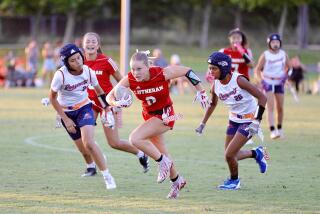Irvine Sign Restraint Signals a Less-Is-More Philosophy
- Share via
Dear Street Smart:
Irvine Center Drive does not have any speed limit signs from the exit going south on the San Diego Freeway until almost to Lake Forest Drive. Why, and what is the speed limit?
Dale E. Cornelison, Laguna Hills
If it’s not posted, you may drive the maximum urban speed of 55 m.p.h., assuming that poor conditions such as rain don’t require you to travel slower, as required by California’s Basic Speed Law. The law says it’s illegal to drive faster than it is safe under the prevailing conditions.
It’s common for streets in Irvine not to have speed limit signs, if they are not required by law. If a street is posted, signs generally will be at major intersections. But Irvine, always on the cutting edge, embraces a philosophy of the fewer signs the better.
“We’re probably a leader in that area. Most cities tend to over-sign,” said Steve Libring, a senior transportation engineer with the city. “If you inundate the driver with a whole flurry of signs, there is a chance they may miss an important message.”
And drivers are inundated, with the average motorist pummeled by 1,000 signs a day, Libring estimated. So, in many areas, the city relies on motorists to know the state vehicle code and posts signs only when extra notice is needed.
Since the vehicle code states that the maximum street speed is 55 m.p.h., unless regulated, Irvine doesn’t restate the fact with distracting signs. Likewise, the city won’t post 25 m.p.h. signs in residential areas, since the vehicle code also covers that.
Of course, while improving safety through select announcements, fewer signs means the streets look a bit tidier and that the city also saves a few bucks on maintenance.
By the way, you can drive 55 m.p.h. on many of Irvine’s major boulevards. Only about a dozen or so of the main streets have a lower speed limit. Signal timing, good pavement and other factors mean that drivers can go that fast quite safely.
“Irvine has some very well-engineered roadways,” Libring explained. “All those things contribute to being able to maintain higher speeds.”
Nor is faster dangerous, Libring said. Speed-related accidents typically happen when there are large speed variances between lanes. Uniform speed, even high speed, can reduce accidents. Irvine proves this, with a low history of speed-related accidents, Libring said. Freeways, which also have low accident rates during off-peak hours when traffic is moving rapidly, are another example.
Dear Street Smart:
Since construction started along Newport Boulevard, many motorists have been using Irvine Avenue instead. This has led to two problems. First, the traffic lights along Irvine Avenue are not synchronized for the increased traffic flow. This leads to slow-moving traffic, especially at rush hours. Second, the pavement surface on Irvine Avenue is deteriorating rapidly, especially the southbound lanes between 19th and 17th streets. Is anyone going to do something about these two issues? And if so, when?
Jonathan M. Fine, Newport Beach
And I thought I was the only one who knew about using Irvine Avenue as a bypass! You are correct, many motorists have seized upon Irvine Avenue as a way to avoid the Newport Boulevard construction blues. Happily, solutions to your complaints are in the works.
In the next few weeks, the signals along Irvine Avenue will be coordinated. They had already been re-timed once, when it was noticed that more cars were seeking out Irvine Avenue, said Newport Beach traffic engineer Rich Edmonston.
As for your second issue, work will begin to resurface Irvine Avenue from 16th to Santiago Drive/22nd Street, probably by the end of this month. It’s a cooperative project between the cities of Newport Beach and Costa Mesa. Newport maintains the northbound side of Irvine Avenue; Costa Mesa maintains the southbound side.
The resurfacing will take most of the summer to complete. It was scheduled for summer to accommodate students in the area who bike to nearby Newport Harbor High and Ensign Intermediate schools.
Dear Street Smart:
How about a left-turn signal system at the intersection of Bastanchury and Laguna roads in Fullerton? That intersection is a local shopper’s nightmare during rush hour. It’s gridlock, compounded by the danger of being hit when turning into Great Western Bank, immediately south of the intersection. Every time I go, I expect to be rear-ended by a driver who is unfamiliar with the terrain.
Louise Armstrong, Fullerton
A left-turn signal would only compound congestion in the area, said Fullerton traffic engineer Paul Smith. About 3,000 cars an hour move on Bastanchury during peak times, with only a small number turning onto Laguna. Stopping the main flow of traffic, especially so close to the busy intersection of Harbor Boulevard and Bastanchury, would play havoc with the traffic flow in the area, Smith said. While shoppers might like the convenience of a turn signal, commuters probably would raise an uproar.
As for being rear-ended, Smith said there’s not much a left-turn signal could do to prevent that. It comes down to drivers’ being aware of their surroundings, an awareness that can be diminished during the demands of rush-hour driving.
A suggestion is to avoid shopping during busy traffic times, until the masses have passed. And Smith suggested that taking an alternate route, Harbor to Valencia Mesa Drive to Laguna, would save you from making a left on Bastanchury. It’s a little bit longer, but it might be less nerve-racking.
More to Read
Sign up for Essential California
The most important California stories and recommendations in your inbox every morning.
You may occasionally receive promotional content from the Los Angeles Times.













